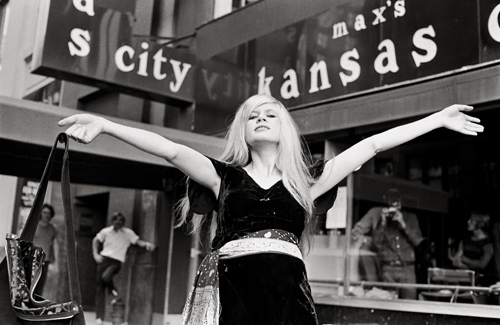"Max's Kansas City was the exact place where Pop art and pop life came together in New York in the sixties," said Andy Warhol, who would know, and who in 1968 even moved his Factory downtown to be closer to the raucous Park Avenue South hangout. And while a Korean deli now fills the address that once housed the debauched after-hours shenanigans of artists like Robert Smithson and Carolee Schneemann, celebrities like Cary Grant and Mel Brooks, and musicians like Iggy Pop and Debbie Harry, the Max's legacy continues to thrill.
Which is perhaps why this month two galleries are offering shows centered on the Max's myth, one at Steven Kasher Gallery (through October 9) featuring work by the clubhouse's patrons John Chamberlain, Forrest Myers, Larry Zox, and Neil Williams, and another at Loretta Howard Gallery showcasing work by better-known Max's devotees like James Rosenquist, Vito Acconci, Brigid Berlin, Dan Flavin, Lawrence Weiner, and Frank Stella.
Visit ARTINFO to see a slideshow of images from the new catalogue, which describes the exploits of sundry artists, musicians, and other celebrities at the storied clubhouse.

Anton Perich's "Girl Standing in Front of Max's" is one of the many period photographs in Steven Kasher's "Max's Kansas City: Art, Glamour, Rock and Roll." / Courtesy Anton Perich and Steven Kasher Gallery, NYC
While today we may have one-off art-world gatherings that recall the bygone downtown vibe, we wax nostalgic about Max's Kansas City because we don't really have an equivalent. The book accompanying the show at Steven Kasher, published by Abrams Image, will only serve to rub in this deficiency -- although hearing about some of the sordid, drug-fueled mayhem that went down there takes away some of the myth's appeal.
Titled Max's Kansas City: Art, Glamour, Rock and Roll, the catalogue includes a number of texts -- including a 1974 interview between the owner, Mickey Ruskin, and Ramones manager Danny Fields -- but the main attraction is its wealth of photographs and odd blurbs documenting three decades of the art world.
Steven Watson writes in one essay that "deciding who came in was owner Mickey Ruskin's way of 'curating' people." The pieces of photographic ephemera and scribbled memories, only some of which are collected in this book, amount to the late Ruskin's grand exhibition. In honor of this achievement, ARTINFO perused Kasher's book to cull 11 things you didn't know about Max's. And boy, are they Grade-A juicy.
- Some of the more boisterous events at Max's include the time when Andrea "Whipps" Feldman crooned "Everything's Coming Up Roses" while she "performed sex with a Coke bottle," and the occasion on which Jim Morrison peed in a partially full bottle of wine and gave it to waitress, convincing her that it was a nearly untouched bottle of fine vintage. She took it home.
Ah yes, now we understand.
- Emma Allen
Visit ARTINFO to see photos from the glory days of Max's Kansas City and to learn more about the Max's Kansas City-inspired shows.
Follow ARTINFO on Foursquare: http://foursquare.com/artinfo